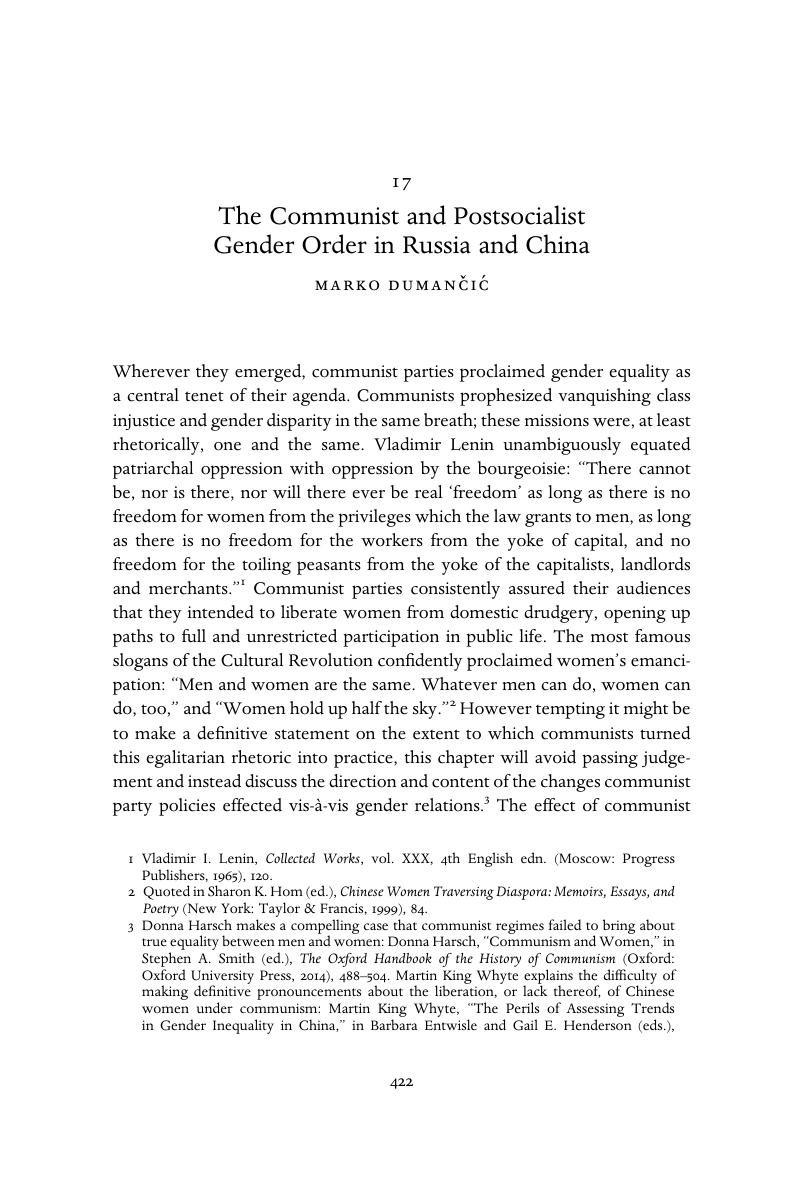Book contents
- The Cambridge History of Communism
- The Cambridge History of Communism
- Endgames? Late Communism in Global Perspective, 1968 to the Present
- Copyright page
- Contents
- Plates
- Figures
- Contributors to Volume III
- Introduction to Volume III
- Part I Globalism and Crisis
- Part II Everyday Socialism and Lived Experiences
- 11 The Aging Pioneer: Late Soviet Socialist Society, Its Challenges and Challengers
- 12 Communism and Religion
- 13 Visualizing the Socialist Public Sphere
- 14 Communist Propaganda and Media in the Era of the Cold War
- 15 The Zones of Late Socialist Literature
- 16 Feminism, Communism and Global Socialism: Encounters and Entanglements
- 17 The Communist and Postsocialist Gender Order in Russia and China
- Part III Transformations and Legacies
- Index
- Plate Section
- References
17 - The Communist and Postsocialist Gender Order in Russia and China
from Part II - Everyday Socialism and Lived Experiences
Published online by Cambridge University Press: 28 September 2017
- The Cambridge History of Communism
- The Cambridge History of Communism
- Endgames? Late Communism in Global Perspective, 1968 to the Present
- Copyright page
- Contents
- Plates
- Figures
- Contributors to Volume III
- Introduction to Volume III
- Part I Globalism and Crisis
- Part II Everyday Socialism and Lived Experiences
- 11 The Aging Pioneer: Late Soviet Socialist Society, Its Challenges and Challengers
- 12 Communism and Religion
- 13 Visualizing the Socialist Public Sphere
- 14 Communist Propaganda and Media in the Era of the Cold War
- 15 The Zones of Late Socialist Literature
- 16 Feminism, Communism and Global Socialism: Encounters and Entanglements
- 17 The Communist and Postsocialist Gender Order in Russia and China
- Part III Transformations and Legacies
- Index
- Plate Section
- References
Summary

- Type
- Chapter
- Information
- The Cambridge History of Communism , pp. 422 - 446Publisher: Cambridge University PressPrint publication year: 2017
References
Suggested Readings
Bibliographical Essay
The fields of women’s studies and critical studies on men and masculinities have had an uneven trajectory. While scholarship on the position of women in the USSR and the PRC traces its roots to the late 1960s and early 1970s, critical studies on Chinese and Russo-Soviet masculinities did not emerge until the late 1990s. While women’s studies constitute a fundamental part of both communist and postcommunist studies, the scholarship on the masculinity side of the gender equation remains in a relatively nascent phase.
For the evolution of Russian and Soviet women’s history, see Alpern, Barbara Engel, “New Directions in Russian and Soviet Women’s History,” in Nadell, Pamela S. and Haulman, Kate (eds.), Making Women’s Histories: Beyond National Perspectives (New York: New York University Press, 2013), 38–60. For the development of scholarly studies on Chinese women in both China and the West, see Hershatter, Gail and Zheng, Wang, “Chinese History: A Useful Category of Gender Analysis,” American Historical Review 113, 5 (2008), 1404–21. The position of women under communism is analyzed in Harsch, Donna, “Communism and Women,” in Smith, Stephen A. (ed.), The Oxford Handbook of the History of Communism (Oxford: Oxford University Press, 2014), 488–504.
A useful overview of scholarship on Russian and Soviet masculinities emerges in Clements, Barbara Evans, Friedman, Rebecca and Healey, Dan (eds.), Russian Masculinities in History and Culture (Basingstoke: Palgrave, 2002). A theoretical and longue durée approach to Chinese masculinity receives coverage in Louie, Kam, Theorising Chinese Masculinity: Society and Gender in China (Cambridge: Cambridge University Press, 2002).
Two works that delineate the Soviet and Chinese Communist Parties’ paradoxical attitude toward women, as simultaneously sociopolitically regressive elements and embodiments of historical progress and social change, see Wood, Elizabeth A., The Baba and the Comrade: Gender and Politics in Revolutionary Russia (Bloomington: Indiana University Press, 1997); and Chen, Tina Mai, “Female Icons, Feminist Iconography? Socialist Rhetoric and Women’s Agency in 1950s China,” Gender and History 15, 2 (2003), 268–95.
Evaluations of Soviet women’s contribution to Stalin’s industrial revolution and of their World War II combat roles are presented, respectively, in Goldman, Wendy, Women at the Gates: Gender and Industry in Stalin’s Russia (Cambridge: Cambridge University Press, 2002), and Krylova, Anna, Soviet Women in Combat: A History of Violence on the Eastern Front (Durham, NC: Duke University Press, 2011). The transformation of women’s sociopolitical roles under Mao receives scrutiny in Honig, Emily, “Socialist Sex: The Cultural Revolution Revisited,” Modern China 29, 2 (2003), 143–75, and Honig, Emily, “Iron Girls Revisited: Gender and the Politics of Work in the Cultural Revolution,” in Entwisle, Barbara and Henderson, Gail E. (eds.), Re-Drawing Boundaries: Work, Households, and Gender in China (Berkeley: University of California Press, 2000), 97–110.
For the fundamental transformation the masculinity ideal underwent during the first three decades of Soviet rule, see both Borenstein, Eliot, Men Without Women: Masculinity and Revolution in Russian Fiction, 1917–1929 (Durham, NC: Duke University Press, 2001), and Kaganovsky, Lilya, How the Soviet Man Was Unmade: Cultural Fantasy and Male Subjectivity Under Stalin (Pittsburgh: University of Pittsburgh Press, 2008). For the Chinese revolutionary project’s impact on the social construct of masculinity, see Hinsch, Bret, Masculinities in Chinese History (Lanham, MD: Rowman & Littlefield, 2013), 151–70.
The various elements of the late socialist Soviet masculinity crisis are featured in Zdravomyslova, Elena and Temkina, Anna, “The Crisis of Masculinity in Late Soviet Discourse,” Russian Social Science Review 54, 1 (2013), 40–61. Two studies that identify the rapidly changing gender politics after Mao’s death include Baranovitch, Nimrod, China’s New Voices: Popular Music, Ethnicity, Gender, and Politics, 1978–1997 (Berkeley: University of California Press, 2003), as well as Zheng, Wang, “From Xianglin’s Wife to the Iron Girls: The Politics of Gender Representation,” in Goodman, David S. G. (ed.), Handbook of the Politics of China (Northampton, MA: Edward Edgar, 2015).
For an overview of how men’s domestic roles changed after the fall of the Soviet Union, see Ashwin, Sarah and Lytkina, Tatyana, “Men in Crisis in Russia: The Role of Domestic Marginalization,” Gender and Society 18, 2 (2004), 189–206. The emergence of the neoliberal entrepreneurial ethos and its impact on gender relations are covered in Mazzarino, Andrea, “Entrepreneurial Women and the Business of Self-Development in Global Russia,” Signs 38, 3 (2013), 623–45, and Yurchak, Alexei, “Russian Neoliberal: The Entrepreneurial Ethic and the Spirit of ‘True Careerism,’” Russian Review 62, 1 (2003), 72–90. The hypermasculine and ethnoexclusivist politics of the Putin era is examined in Riabov, Oleg and Riabova, Tatiana, “The Remasculinization of Russia? Gender, Nationalism, and the Legitimation of Power Under Vladimir Putin,” Problems of Post-Communism 61, 2, (2014), 23–35.
The realities of female entrepreneurs in China receive treatment in Chen, Minglu, Tiger Girls: Women and Enterprise in the People’s Republic of China (Abingdon: Routledge, 2011). Monographs on women factory workers include Ngai, Pun, Made in China: Women Factory Workers in a Global Workplace (Durham, NC: Duke University Press, 2005), and Jacka, Tamara, Rural Women in Urban China: Gender, Migration, and Social Change (Armonk, NY: M. E. Sharpe, 2006). For a comprehensive treatment of contemporary Chinese masculinities, see Song, Geng and Hird, Derek, Men and Masculinities in Contemporary China (Leiden: Brill, 2014).



